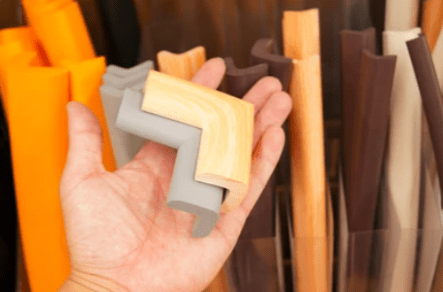Overview
All buildings have intrinsic weaknesses, but corners and edges are especially prone to damage from knocks, impacts, and mishaps. In the field of infrastructure protection, corner guards are unsung heroes since they offer a simple yet effective defense against this widespread problem.
These modest protectors are available in a range of styles and materials, each suited to a particular application or setting. They improve safety and aesthetics in addition to providing physical protection. Their adaptability is demonstrated by the range of industries in which they are used, from residential dwellings to healthcare institutions.
This article seeks to clarify the important function of corner guards by examining their many designs, the materials they are made of, the significant advantages they provide, and the installation and maintenance procedures. It also anticipates new trends, demonstrating how corner guards will change to meet shifting needs and keep up with technology developments in the sector.
Corner guards: what are they?
Corner guards reduce damage from wear and daily impacts by acting as a buffer for the exposed edges of walls and furniture. They are vital in places with heavy traffic, such as schools, hospitals, and offices, as they guard against chipping, scratches, and more severe structural damage.
These straightforward yet sturdy gadgets are becoming more and more popular in households as well, providing protection from life’s little bumps and bangs. Corner guards are an essential part of maintaining the longevity and aesthetics of both buildings and furniture because they absorb and deflect impacts while maintaining the integrity and beauty of interior spaces.
Types of Corner Guards

Residential vs. Commercial: Corner guards in homes typically have softer materials and more diversified designs with an emphasis on baby-proofing or aesthetics. Commercial settings, on the other hand, require corner guards that are more durable and long-lasting in order to handle heavy traffic and collisions. These guards are usually composed of reinforced plastic or metal, which is a harder material.
Surface-mounted versus flush-mounted: Corner guard installation methods, whether flush or surface-mounted, have a big impact on how well they integrate into the design and how safe they are. Surface mounts enable simple installation and a wider range of design options, while flush mounts offer a seamless appearance and strong resistance.
Comparing Flexible and Rigid: Different corner guards meet different purposes; some are designed to withstand strong impacts, providing customized protection for any setting, while others excel at absorbing shock from everyday knocks.
Components of Corner Guards
Metal: Stainless steel and aluminum’s strength and beauty.
Plastic: Polycarbonate and PVC’s cost-effectiveness and adaptability.
Rubber: Its capacity to absorb shock and adaptability for use in industrial environments.
Advantages of Putting up Corner Guards
Protection: Corner guards protect the structural integrity of furniture and buildings.
Safety: The protection against sharp edge injuries provided by corner guards.
Aesthetics: Corner guards can improve or preserve a space’s attractiveness.
Cost Savings: By lowering the frequency and cost of maintenance and repairs due to impact damage, corner guard investments can dramatically reduce long-term costs.
Corner Guard Applications
Hygiene and safety play a crucial role in hospitals and other healthcare facilities.
Ensuring children’s safety in schools and daycare centers by providing suitable corner guards.
Commercial buildings: Guarding heavily traveled sections against normal wear and tear.
Residential Spaces: Keeping homes safe and aesthetically pleasing.
Corner guard installation preparation: actions to do to make sure the surface is prepared for installation.
Methods: Depending on the type of protection and the material of the wall, the best way to attach it—adhesive, screws, or another method—will guarantee a tight and durable fit.
Common Errors: What to Steer Clear of to Ensure a Robust and Secure Installation.
Upkeep and Concern

Corner guard performance and longevity depend on proper maintenance. To prevent scratches on metal guards, use gentle detergents and stay away from abrasive instruments. Soft towels and mild cleaning chemicals work best for plastic versions.
Rubber corner guards require only basic cleaning with soap and water. Steer clear of aggressive chemicals that could erode the integrity or finish of any material. It’s important to conduct routine inspections; look for any loose fittings or damage indicators. This guarantees that they stay firmly in place and offer ongoing protection.
Corner guards may be kept in top condition and their functioning and look preserved by following these specific cleaning instructions and performing regular inspections.
Upcoming Patterns
Sustainable Materials: Advances in environmentally friendly materials and production techniques.
The possibility of incorporating technology to track hits or wear in “smart corner guards”
Design Evolution: As interior design trends change, corner guards are evolving to fit into newer, sleeker styles that come in a broader variety of colors and materials. This allows them to compliment overall design schemes and blend in seamlessly with current aesthetics while still serving a protective purpose.
In summary
Corner guards are crucial for maintaining the structural integrity and safety of a variety of places, although frequently being disregarded as minor elements. By shielding corners from wear and corrosion, these protective fixtures increase the longevity of infrastructure while preserving its visual appeal. Corner guards can be customized to match the unique requirements of every location, from busy commercial spaces to calm residential areas, since they come in a wide variety of types and materials.
We hope you found this information helpful in your journey to create a safer environment for your family. At GuardWell Safety, we understand that every home is unique, and so are your child-proofing needs. That’s why we offer a Free Child-Proofing Consultation tailored to your specific requirements. Let our experts help you identify potential hazards and provide personalized solutions to make your home a secure haven for your little ones. Book your free consultation today and take the first step towards peace of mind.






